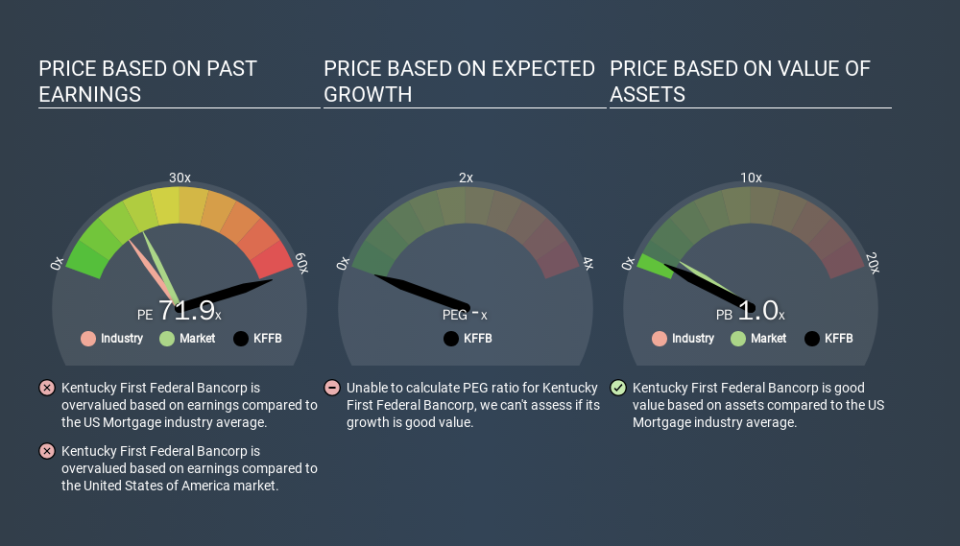Read This Before You Buy Kentucky First Federal Bancorp (NASDAQ:KFFB) Because Of Its P/E Ratio

Kentucky First Federal Bancorp (NASDAQ:KFFB) shares have retraced a considerable in the last month. But there's still good reason for shareholders to be content; the stock has gained 6.2% in the last 90 days. The stock has been solid, longer term, gaining 12% in the last year.
Assuming no other changes, a sharply higher share price makes a stock less attractive to potential buyers. While the market sentiment towards a stock is very changeable, in the long run, the share price will tend to move in the same direction as earnings per share. The implication here is that deep value investors might steer clear when expectations of a company are too high. One way to gauge market expectations of a stock is to look at its Price to Earnings Ratio (PE Ratio). A high P/E ratio means that investors have a high expectation about future growth, while a low P/E ratio means they have low expectations about future growth.
View our latest analysis for Kentucky First Federal Bancorp
Does Kentucky First Federal Bancorp Have A Relatively High Or Low P/E For Its Industry?
Kentucky First Federal Bancorp's P/E of 71.95 indicates some degree of optimism towards the stock. The image below shows that Kentucky First Federal Bancorp has a significantly higher P/E than the average (14.4) P/E for companies in the mortgage industry.
Kentucky First Federal Bancorp's P/E tells us that market participants think the company will perform better than its industry peers, going forward. Clearly the market expects growth, but it isn't guaranteed. So further research is always essential. I often monitor director buying and selling.
How Growth Rates Impact P/E Ratios
When earnings fall, the 'E' decreases, over time. That means even if the current P/E is low, it will increase over time if the share price stays flat. A higher P/E should indicate the stock is expensive relative to others -- and that may encourage shareholders to sell.
Kentucky First Federal Bancorp shrunk earnings per share by 23% over the last year. And over the longer term (5 years) earnings per share have decreased 14% annually. This growth rate might warrant a below average P/E ratio.
Remember: P/E Ratios Don't Consider The Balance Sheet
Don't forget that the P/E ratio considers market capitalization. In other words, it does not consider any debt or cash that the company may have on the balance sheet. Theoretically, a business can improve its earnings (and produce a lower P/E in the future) by investing in growth. That means taking on debt (or spending its cash).
Spending on growth might be good or bad a few years later, but the point is that the P/E ratio does not account for the option (or lack thereof).
Kentucky First Federal Bancorp's Balance Sheet
Kentucky First Federal Bancorp has net debt worth 75% of its market capitalization. This is enough debt that you'd have to make some adjustments before using the P/E ratio to compare it to a company with net cash.
The Verdict On Kentucky First Federal Bancorp's P/E Ratio
Kentucky First Federal Bancorp's P/E is 71.9 which suggests the market is more focussed on the future opportunity rather than the current level of earnings. With meaningful debt and a lack of recent earnings growth, the market has high expectations that the business will earn more in the future. Given Kentucky First Federal Bancorp's P/E ratio has declined from 71.9 to 71.9 in the last month, we know for sure that the market is less confident about the business today, than it was back then. For those who prefer to invest with the flow of momentum, that might be a bad sign, but for a contrarian, it may signal opportunity.
Investors should be looking to buy stocks that the market is wrong about. If the reality for a company is better than it expects, you can make money by buying and holding for the long term. We don't have analyst forecasts, but you could get a better understanding of its growth by checking out this more detailed historical graph of earnings, revenue and cash flow.
Of course, you might find a fantastic investment by looking at a few good candidates. So take a peek at this free list of companies with modest (or no) debt, trading on a P/E below 20.
If you spot an error that warrants correction, please contact the editor at editorial-team@simplywallst.com. This article by Simply Wall St is general in nature. It does not constitute a recommendation to buy or sell any stock, and does not take account of your objectives, or your financial situation. Simply Wall St has no position in the stocks mentioned.
We aim to bring you long-term focused research analysis driven by fundamental data. Note that our analysis may not factor in the latest price-sensitive company announcements or qualitative material. Thank you for reading.



